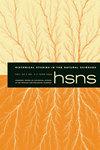Yeast Sequencing
IF 0.3
3区 哲学
Q2 HISTORY & PHILOSOPHY OF SCIENCE
引用次数: 0
Abstract
This paper examines the model of network genomics pioneered in the late 1980s and adopted in the European Commission-led Yeast Genome Sequencing Project (YGSP). It contrasted with the burgeoning large-scale center model being developed in the United States to sequence the yeast genome, chiefly as a pilot for tackling the human genome. We investigate the operation and connections of the two models by exploring a co-authorship network that captures different types of sequencing practices. In our network analysis, we focus on institutions that bridge both the European and American yeast whole-genome sequencing projects, and such concerted projects with non-concerted sequencing of yeast DNA. The institutions include two German biotechnology companies and Biozentrum, a research institute at Universität Basel that adopted yeast as a model to investigate cell biochemistry and molecular biology. Through assessing these bridging institutions, we formulate two analytical distinctions: between proximate and distal, and directed and undirected sequencing. Proximate and distal refer to the extent that intended users of DNA sequence data are connected to the generators of that data. Directed and undirected capture the extent to which sequencing was part of a specific research program. The networked European model, as mobilized in the YGSP, enabled the coexistence and cooperation of institutions exhibiting different combinations of these characteristics in contrast with the more uniformly distal and undirected large-scale centers. This contributes to broadening the historical boundaries of genomics and presenting a thicker historiography, one that inextricably meshes genomics with the trajectories of biotechnology and cell biology. This essay is part of a special issue entitled The Sequences and the Sequencers: A New Approach to Investigating the Emergence of Yeast, Human, and Pig Genomics, edited by Michael García-Sancho and James Lowe.酵母测序
本文研究了20世纪80年代末开创的网络基因组学模型,该模型被欧盟委员会领导的酵母基因组测序计划(YGSP)所采用。这与美国正在发展的大规模中心模式形成了鲜明对比,后者主要是作为解决人类基因组问题的试点,用于对酵母基因组进行测序。我们通过探索捕获不同类型测序实践的合作作者网络来研究这两个模型的操作和联系。在我们的网络分析中,我们重点关注欧洲和美国酵母全基因组测序项目的机构,以及酵母DNA非协调测序的协调项目。这些机构包括两家德国生物技术公司和位于Universität巴塞尔的研究机构Biozentrum,该机构采用酵母作为研究细胞生物化学和分子生物学的模型。通过评估这些桥接机构,我们制定了两个分析区别:近端和远端,定向和非定向测序。近端和远端是指DNA序列数据的预期用户连接到该数据的生成器的程度。定向和非定向捕获排序是特定研究计划的一部分的程度。网络化的欧洲模式,正如在YGSP中所动员的那样,与更统一的远端和无方向的大规模中心相比,使表现出这些特征的不同组合的机构能够共存和合作。这有助于拓宽基因组学的历史边界,呈现更厚的史学,将基因组学与生物技术和细胞生物学的轨迹不可分割地结合在一起。这篇文章是由Michael García-Sancho和James Lowe编辑的题为“序列和测序者:研究酵母、人类和猪基因组学出现的新方法”的特刊的一部分。
本文章由计算机程序翻译,如有差异,请以英文原文为准。
求助全文
约1分钟内获得全文
求助全文
来源期刊

Historical Studies in the Natural Sciences
社会科学-科学史与科学哲学
CiteScore
1.00
自引率
0.00%
发文量
24
审稿时长
>12 weeks
期刊介绍:
Explore the fascinating world of Historical Studies in the Natural Sciences, a journal that reveals the history of science as it has developed since the 18th century. HSNS offers in-depth articles on a wide range of scientific fields, their social and cultural histories and supporting institutions, including astronomy, geology, physics, genetics, natural history, chemistry, meteorology, and molecular biology. Widely regarded as a leading journal in the historiography of science and technology, HSNS increased its publication to five times per year in 2012 to expand its roster of pioneering articles and notable reviews by the most influential writers in the field.
 求助内容:
求助内容: 应助结果提醒方式:
应助结果提醒方式:


